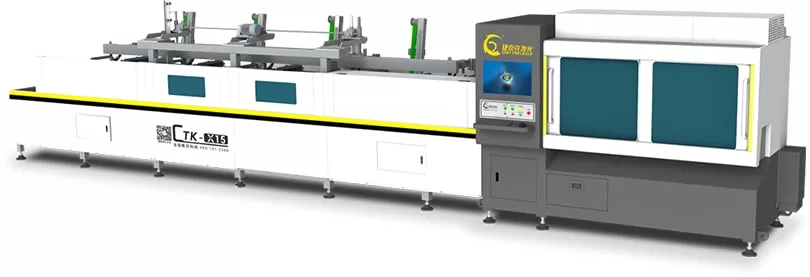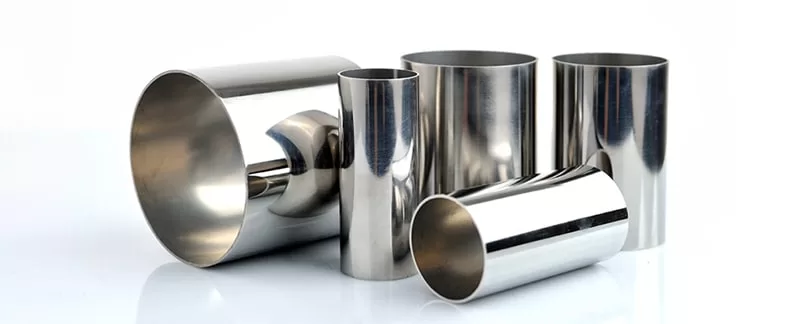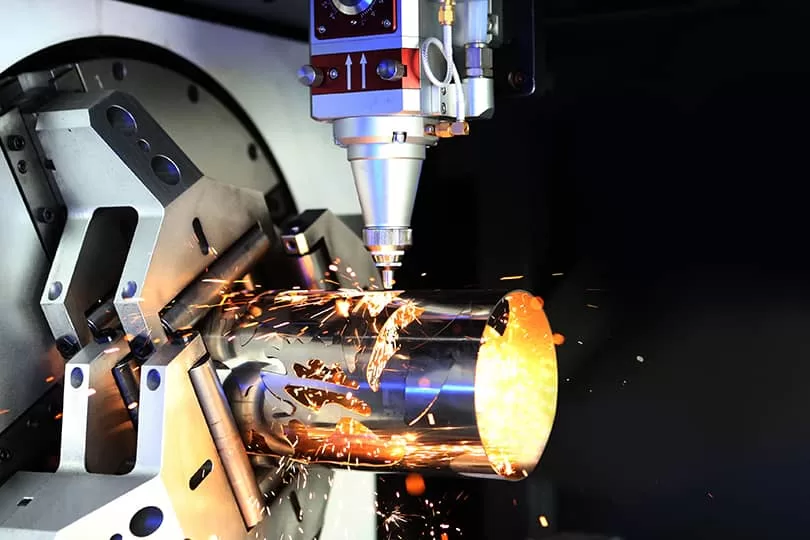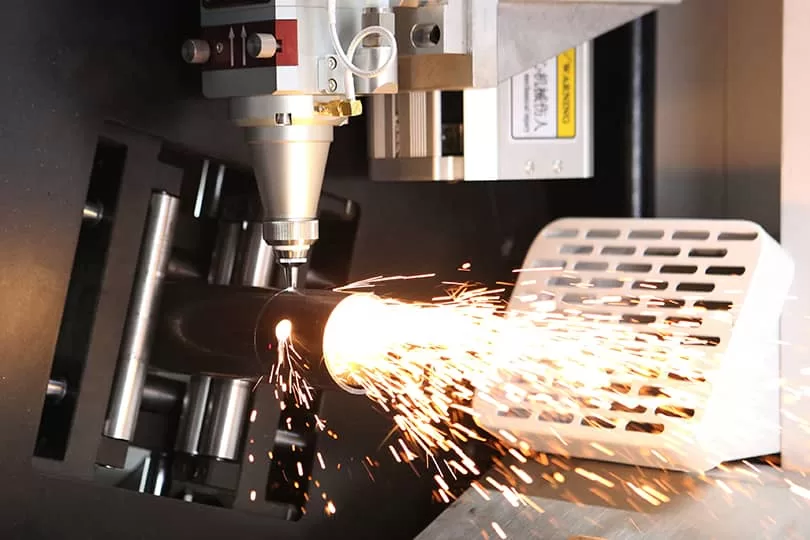The Ultimate Guide to Laser Metal Cutting Machines
Contents
- Types of Laser Metal Cutting Machines
- The Versatility of Materials in Laser Metal Cutting Machines
- Key Technical Parameters of Laser Metal Cutting Machines
- Applications of Laser Metal Cutting Machines
- Laser Metal Cutting Machine Cost Factors
- Safety Guidelines for Laser Metal Cutting Machines
- Innovations and Trends in Laser Metal Cutting Machines
- Conclusion
Laser metal cutting machine is a device that uses laser beam to cut metal materials (stainless steel, carbon steel, aluminum, copper, etc.).
Laser metal cutting machines play a great role in the manufacturing industry. They are able to cut a variety of metals with great speed and precision. At the same time, laser metal cutting machines are also versatile and can achieve cutting of various complex shapes.
This guide will provide an in-depth look into the world of laser metal cutting machines, covering their types, materials, technical parameters, applications, cost factors, safety guidelines, innovations and trends.
Types of Laser Metal Cutting Machines
Laser metal cutting machines are widely used in the field of metal processing and can be divided into several different types according to different laser emission media and working principles.
Below, we will introduce four common types of laser metal cutting machines: fiber laser cutting machines, CO2 laser cutting machines, YAG laser cutting machines, and solid-state laser cutting machines.
Fiber Laser Cutting Machines
What is a fiber laser cutting machine? A fiber laser cutting machine is a kind of metal processing equipment that uses a fiber laser as a cutting tool.
It uses a fiber laser as the laser emission source. By focusing the laser beam onto the surface of the workpiece, it generates a high temperature on the surface of the workpiece, thereby achieving the cutting of metal materials.
Fiber laser cutting machines have high precision and efficiency. On one hand, because the fiber laser cutting machine uses laser technology, it has high positioning accuracy and cutting accuracy, and can achieve precise cutting of metal materials. On the other hand, fiber laser cutting machines have fast cutting speed and high work efficiency, and can meet the needs of mass production.
They are suitable for high-speed cutting of thin plates and are widely used in metal processing, electronic equipment manufacturing, and other fields.
CO2 Laser Cutting Machines
CO2 laser cutting machine is a device that uses a laser beam generated by a CO2 gas laser to cut materials. It focuses the laser beam onto the workpiece surface through an optical system, causing local melting or vaporization of the workpiece surface to achieve cutting of metal materials.
CO2 laser cutting machines have the characteristics of fast cutting speed, good cutting quality and large cutting thickness. They are suitable for cutting various metal materials (including stainless steel, aluminum alloy, copper, etc.), and can also cut some non-metal materials (such as plastic, wood, etc.).
They are suitable for cutting medium-thick plates and are widely used in metal processing, automobile manufacturing, electronic equipment, and other fields.
YAG Laser Cutting Machines
YAG laser cutting machine is a device that uses the laser beam generated by the solid YAG (Yttrium Aluminum Garnet) laser to cut materials.
The YAG laser transmits the laser beam to the cutting head through the optical system, and then focuses the laser beam onto the workpiece surface through the lens, causing local melting or vaporization of the workpiece surface to achieve cutting of metal materials.
YAG laser cutting machines have the advantages of high cutting precision, fast cutting speed, and good cutting quality. They are suitable for fine cutting and engraving of metal materials, such as stainless steel, aluminum alloy, copper, etc.
Solid-State Laser Cutting Machines
Solid-state laser cutting machines are efficient and accurate metal cutting equipment. They use laser beams generated by solid-state lasers to cut metal materials (including stainless steel, aluminum alloys, copper, etc.).
Solid-state lasers produce a high-energy laser beam by converting electrical energy into light energy, which can generate high temperatures on the metal surface, thereby melting or vaporizing the metal material for cutting purposes.
Due to the high energy conversion efficiency and stability of solid-state lasers, solid-state laser cutting machines usually have higher cutting speeds and lower energy consumption. They can handle high speed cutting of thick plates.
In general, different types of laser metal cutting machines have certain differences in working principles, cutting speed, cutting quality, etc. Therefore, when choosing a laser metal cutting machine, users should choose the appropriate type according to their needs.

The Versatility of Materials in Laser Metal Cutting Machines
Laser metal cutting machines use high energy density laser beams to cut metal materials. They have the advantages of fast cutting speed, high cutting quality, and easy operation.
Laser metal cutting machines can handle a variety of metal materials, including but not limited to the following common materials:
Stainless Steel
Stainless steel is a commonly used metal material. It has the advantages of corrosion resistance, high temperature resistance and high strength. Stainless steel is widely used in various fields because of its excellent properties.
Laser metal cutting machines cut stainless steel very well. Why say that? Because they can achieve high precision and smooth cutting edges. Moreover, the use of laser cutting can avoid material deformation or damage while maintaining the flatness and accuracy of the cutting edge.
The most important thing when cutting stainless steel is to control the cutting speed and focus position. Because the cutting speed is too fast, the cutting edge burrs or burns will be caused, and the focus position is not appropriate, which will affect the cutting quality and speed.
Therefore, when cutting stainless steel, it is necessary to adjust the cutting parameters reasonably according to the thickness and type of the material to ensure the cutting quality and efficiency.
Carbon Steel
Carbon steel is a common structural material composed of elements such as carbon and iron and has good workability and mechanical properties.
Laser metal cutting machines can cut carbon steel with high speed and high precision. By adjusting parameters such as laser power, cutting speed and focus position, precise cutting of carbon steel plates of different thicknesses and shapes can be achieved.
Whether it is for thinner carbon steel sheets or thicker sheets, laser cutting machines can provide high-quality cutting results. This flexibility makes laser cutting technology widely used in carbon steel processing.
Aluminum
Aluminum is a lightweight metal material with good thermal conductivity. Laser cutting of aluminum materials is one of the very common applications.
Due to the high thermal conductivity of aluminum, a high-power laser is required during laser cutting to ensure the cutting effect. This is mainly because high thermal conductivity will cause the laser beam to be affected by greater thermal diffusion during the cutting process. Therefore, it is necessary to use higher power lasers to increase energy density and achieve better cutting results.
The laser cutting machine has a very good cutting effect on aluminum and can achieve high-speed and high-precision cutting. It is suitable for aluminum plates of various thicknesses (thin, medium-thick, and thick aluminum plates) and shapes (curved aluminum plates, special-shaped aluminum plates, etc.).
Brass
Brass is a yellow metal alloy consisting primarily of copper and zinc. It has excellent electrical and thermal conductivity, as well as good processing properties.
Due to the material properties of brass, laser cutting brass may require some special cutting parameters and techniques. For example, proper adjustment of laser power, cutting speed, and gas assist can result in high-quality cuts in brass.
Titanium
Titanium is a metallic material with excellent corrosion resistance and strength-to-weight ratio.
The main reason why laser metal cutting machines can cut titanium is that the high energy density of the laser is compatible with the characteristics of titanium. Titanium has a high melting point and thermal conductivity, requiring a high-power laser to cut effectively.
The non-contact and high-precision nature of laser cutting makes it one of the ideal processes for cutting high-strength, high-temperature metals such as titanium.
In addition to the above common metal materials, laser metal cutting machines can also cut some special metal alloys and materials, such as tungsten, cast iron, nickel alloys, etc., with strong adaptability and versatility.

Key Technical Parameters of Laser Metal Cutting Machines
Laser metal cutting machine is an important equipment in the field of modern metal processing. Key technical parameters have a great influence on the performance and efficiency of laser metal cutting machines, including cutting thickness, cutting speed, laser power and working area, etc.
Below, we will introduce these four key technical parameters of laser metal cutting machines in detail:
Cutting Thickness
The cutting thickness of the laser metal cutting machine refers to the maximum thickness of the metal material that it can effectively cut.
The cutting thickness of low-power laser metal cutting machines is typically in the range of a few millimeters to roughly twenty millimeters, making them appropriate for thin metal materials. Thick metal materials can be processed using high-power laser metal cutting machines, with cutting thicknesses up to tens of millimeters.
It should be noted that the cutting thickness is not thicker, the better. Why say that? This is due to the possibility of decreased cutting speed and lowered cutting quality as metal sheet thickness rises.
Therefore, when choosing a laser metal cutting machine, it is necessary to choose the appropriate model and power according to the actual cutting needs and material thickness.
Cutting Speed
The cutting speed of a laser metal cutting machine refers to the cutting length that the cutting machine can complete per unit time, usually expressed in millimeters per minute.
Cutting speed is affected by many factors, including laser power, type and thickness of metal material, gas assist conditions, etc. For example, for the same laser power, thinner metal materials will be cut faster, while thicker metal materials will be cut slower.
Therefore, in practical applications, these factors need to be considered comprehensively according to the specific situation to determine the appropriate cutting speed and other process parameters.
Laser Power
Laser power is a very critical parameter for laser metal cutting machines. Because the laser power determines the energy density of the laser beam. And this will directly affect the speed and quality of cutting.
Typically, higher laser power means faster cutting speed and greater cutting depth. On one hand, fast cutting speed can improve the production efficiency of products, which is very important for mass production and applications that require high efficiency.
On the other hand, a greater cutting depth means that the laser cutting machine is able to cut thicker metal materials. This gives it a wider range of applications in industry.
Therefore, when selecting a laser metal cutting machine, it is necessary to select the appropriate laser power according to the processing requirements and material thickness to achieve the best cutting effect and production efficiency.
Working Area
The working area is the largest working area that the laser metal cutting machine can cut. It is usually expressed in terms of length and width. For example, a laser metal cutting machine with a working range of 1500mm×3000mm can handle workpieces 1500mm long and 3000mm wide.
The size of the scope of work is also a critical factor. Because it will directly affect the application range and processing capabilities of the laser metal cutting machine. For example, if the machine has a larger working range, it means that larger workpieces can be processed. This can increase processing flexibility.
Therefore, when choosing a laser metal cutting machine, you need to choose the appropriate working range based on the expected workpiece size and processing needs.
Applications of Laser Metal Cutting Machines
As an efficient and precise metal processing equipment, laser metal cutting machine is widely used in various industries. Its main applications include the following aspects:
Metal Sheet Cutting
Laser metal cutting machines are now the best option for cutting a variety of metal sheets, including copper, aluminum, stainless steel, and carbon steel. This is due to their exceptional speed and precision. They are extensively employed in the aerospace, automotive, and metalworking industries, among others.
Laser cutting can effortlessly handle and accomplish precision cutting on a variety of materials, including thick carbon steel plates and extremely thin stainless steel plates. Furthermore, laser metal cutting machines are highly adaptable and capable of cutting a wide range of intricate shapes (such as circles, squares, special shapes, etc.).
Pipe Cutting
Laser metal cutting machines can also cut pipes of various shapes (including round pipes, square pipes, grooved pipes, etc.).
With laser cutting, precise cutting of pipes can be achieved. It can also ensure that the cuts are smooth and burr-free, which greatly improves the processing quality.
This laser cutting technology is widely used in pipe manufacturing, furniture manufacturing, auto parts, and other fields. For example, in pipe manufacturing, laser cutting machines can be used to cut pipes of various shapes to meet different project needs.
3D Metal Cutting
It is a big technological breakthrough that laser metal cutting machines can perform 3D metal cutting. 3D metal cutting refers to complex and precise cuts on three-dimensional surfaces.
Unlike traditional cutting methods that are limited to flat surfaces, 3D metal cutting allows the creation of complex geometries and contours in metal materials. How is this achieved? Users control the laser beam to cut metal along multiple axes, allowing for intricate designs and precise details.
This capability opens up a wide range of possibilities for a variety of industries, including craft production, architectural decoration, advertising production, and more.
Metal Marking
Metal marking using a laser metal cutting machine is a versatile and efficient process used in a variety of industries. It can engrave or mark metal surfaces with precision.
Unlike traditional marking methods (such as stamping or etching), laser marking has the advantages of high precision, fast speed, and flexible design.
One of the main advantages of using a laser metal cutting machine for metal marking is its ability to produce detailed and permanent marks without damaging the material surface. This makes it ideal for applications requiring high-quality, durable marking, such as the aerospace, automotive and medical industries.

Laser Metal Cutting Machine Cost Factors
The cost factors of laser metal cutting machines include purchase cost, maintenance cost, operating cost, and consumable cost:
Purchase Cost
The purchase cost of a laser metal cutting machine mainly depends on factors such as its specifications, model, and manufacturer.
Different specifications and models of laser metal cutting machines have different cutting capabilities and application ranges, so the prices will also vary. In addition, equipment produced by different manufacturers also differs in quality, performance, and service, and prices will also vary.
Generally speaking, the price of laser metal cutting machines with high power and large working range is higher, while the price of laser metal cutting machines with low power and small working range is relatively low.
Because high-power laser metal cutting machines can process thicker metal sheets and have a wider range of applications, their prices are relatively high. In contrast, low-power laser metal cutting machines are suitable for processing thinner metal sheets and are relatively cheap.
Maintenance Cost
The maintenance costs of laser metal cutting machines include regular maintenance and parts replacement. Regular maintenance includes cleaning the equipment, checking the lubrication system, calibrating the optical path, etc., to ensure the normal operation of the equipment and extend its service life.
In addition, as the equipment is used, some parts will become worn or damaged and need to be replaced in time to ensure the stability and reliability of the equipment.
Fees depend on equipment usage and maintenance standards. Factors such as the frequency of use of the equipment, working environment, and operating methods will all affect the maintenance cost.
In addition, the maintenance standards of the equipment will also affect the level of maintenance costs. Regular maintenance and timely replacement of worn parts can reduce equipment failure rates, reduce maintenance costs and the risk of production interruptions.
Operating Cost
The operating costs of laser metal cutting machines include energy consumption, labor costs and management costs. Among them, energy consumption is one of the most important costs in the operation of laser cutting machines. Laser cutting machines consume a lot of power when working, especially high-power laser cutting machines.
In addition, labor costs are also one of the operating costs of laser cutting machines, including operator wages and training costs. In addition, administrative expenses include management expenses such as production planning and quality control.
Consumables Cost
The consumables of laser metal cutting machines mainly include cutting gas, laser fiber, etc.
Cutting gas is an indispensable consumable in the laser cutting process, and different cutting gases have different prices. Nitrogen and oxygen are commonly used cutting gases and are relatively cheap. Inert gases such as argon are also used in some special cases and are more expensive. Selecting the appropriate cutting gas can be determined based on the processing materials and requirements.
Laser fiber is the core component of the laser cutting machine, used to transmit laser energy to the cutting head. Due to the influence of the working environment and wear and tear of long-term use, laser optical fibers need to be replaced regularly to ensure the normal operation of the equipment.
The frequency of fiber replacement depends on the usage and maintenance standards of the equipment. It is generally recommended to replace the fiber in time when the fiber is aged or damaged to avoid affecting the cutting quality and equipment life.
Safety Guidelines for Laser Metal Cutting Machines
There are also certain safety risks during the use of laser metal cutting machines. In order to help users operate laser metal cutting machines safely, reduce the possibility of accidents, and ensure the safety of personnel and equipment, the following safety guidelines need to be followed:
1. Operational Safety
– To ensure the safe use of the equipment, operators should obtain professional training and comprehend the laser metal cutting machine’s operating procedures and safety measures.
– The operator must always keep a safe distance from the laser beam while it is in use. The laser beam’s increased energy could result in very serious burns.
Check that all parts (lasers, optical fibers, etc.) are in good working condition before turning on the laser metal cutting machine.
– To prevent accumulation that affects safety and cutting effectiveness, remove waste and metal shavings produced by cutting as soon as possible during the cutting process.
2. Maintain Safety
– Regular inspection and maintenance of laser metal cutting machines. Check that the various components of the equipment (cutting head, gas supply system, etc.) are working properly. If a problem is found, repair it in time to ensure the stability and reliability of the device.
– Follow the maintenance manual provided by the manufacturer and replace the worn parts regularly. Laser fibers, lenses, seals, etc., are easily worn parts. Regular replacement can maintain cutting quality and efficiency.
– When performing maintenance operations, power off the device. Moreover, the maintenance personnel should operate in accordance with the operating procedures.
3. Personal Protective Equipment
– Laser metal cutting machines will produce strong light and heat at work, and there is the possibility of sputtering. Therefore, for safety reasons, operators should wear appropriate personal protective equipment (protective glasses, protective clothing, protective gloves, etc.).
– During operation, the operator should stand in a safe position to avoid direct exposure to the laser beam, so as to avoid damage to the skin and eyes.
Innovations and Trends in Laser Metal Cutting Machines
Laser metal cutting machines are key equipment in the field of modern metal processing, and their innovation and development trends directly affect the development direction of the metal processing industry.
With the advancement of technology and changes in market demand, laser metal cutting machines have shown innovation and development trends in the following aspects:
Automation
With the development of industrial automation, laser metal cutting machines are increasingly adopting automation technology.
Automation technology includes automatic loading, automatic unloading, automatic tool changing, and other functions, which can realize the automation and intelligence of the production process and improve production efficiency and product quality.
Through automation technology, a high degree of automation of the production process can be achieved, reducing human input and production cycle, and improving production efficiency.
At the same time, automation can also reduce the impact of human errors and process changes on production, and improve the stability and reliability of production.
Precision Cutting
With the advancement of technology, the cutting accuracy of laser metal cutting machines has been greatly improved, enabling more precise cutting to meet the needs of complex parts processing.
This is mainly due to the continuous innovation and development of laser technology and control systems. Laser technology itself has a high degree of positioning accuracy and energy density, and can achieve high-precision cutting of metal materials.
Additionally, laser metal cutting machines are equipped with advanced CNC systems and intelligent software, which can achieve precise control of the cutting process and improve cutting accuracy and stability.
High-speed Cutting
With the improvement of laser technology and control systems, the cutting speed of laser metal cutting machines is also constantly increasing, which can complete cutting tasks faster and improve production efficiency.
The increase in laser power makes the laser beam have a higher energy density and can cut metal materials faster. Therefore, with the continuous improvement of laser technology and control systems, the cutting speed of laser metal cutting machines will continue to increase, bringing more efficient production methods to the metal processing industry.
Versatility
New laser metal cutting machines have more functions and processing capabilities to satisfy the wide range of market demands.
The new laser metal cutting machine can perform a variety of processing techniques, including three-dimensional cutting, pipe cutting, and special-shaped cutting, in addition to the traditional plane cutting function.
This makes it possible for laser metal cutting machines to be used in a variety of specialized industries, including pipe processing, automotive manufacture, aerospace, and other fields, in addition to the traditional metal processing fields like sheet metal cutting and parts processing.
Green Cutting Technologies
Green cutting technology refers to cutting methods that use environmentally friendly materials and energy. As a pollution-free and exhaust-free cutting method, laser metal cutting machine meets environmental protection requirements and is one of the important directions for future development.
Traditional metal cutting methods (such as flame cutting and plasma cutting) produce a large amount of waste gas and waste residue, causing serious pollution to the environment.
However, the laser metal cutting machine uses the laser beam to directly act on the surface of the workpiece for cutting, without producing waste gas and waste residue, and will not cause pollution to the environment.

Conclusion
In short, laser metal cutting machines are an indispensable tool in the manufacturing industry, offering unmatched precision, speed and versatility in cutting a wide range of metals.
In the future, with the development of science and technology and changes in market demand, laser metal cutting machines will continue to develop, and become more intelligent, more efficient, more accurate, and more adaptable to market demand.
By understanding the types, materials, technical parameters, applications, cost factors, safety guidelines, innovations and trends of laser metal cutting machines, manufacturers can make informed decisions when choosing and operating these machines, thereby increasing the efficiency and productivity of the metal manufacturing process.
